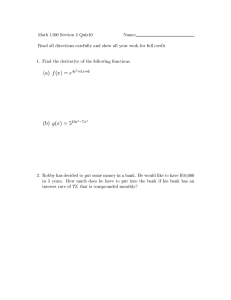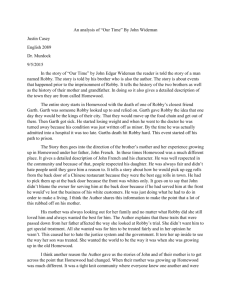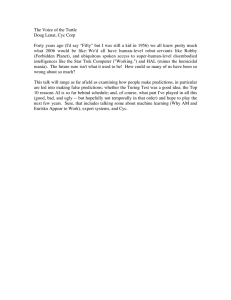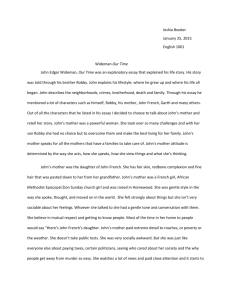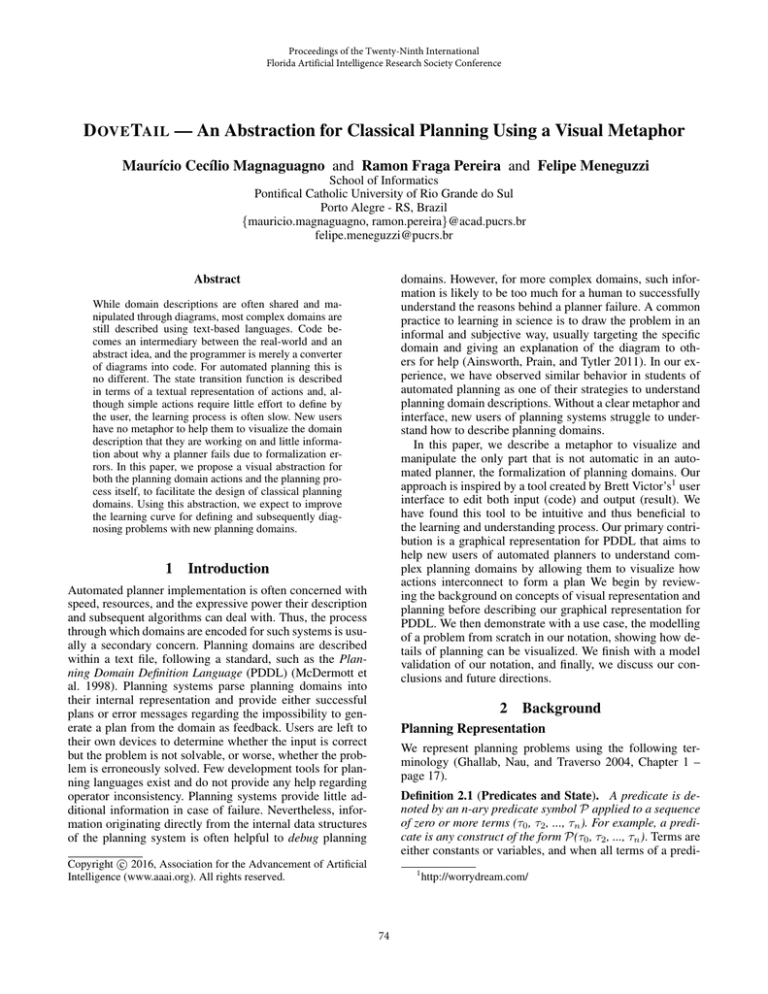
Proceedings of the Twenty-Ninth International
Florida Artificial Intelligence Research Society Conference
D OVE TAIL — An Abstraction for Classical Planning Using a Visual Metaphor
Maurı́cio Cecı́lio Magnaguagno and Ramon Fraga Pereira and Felipe Meneguzzi
School of Informatics
Pontifical Catholic University of Rio Grande do Sul
Porto Alegre - RS, Brazil
{mauricio.magnaguagno, ramon.pereira}@acad.pucrs.br
felipe.meneguzzi@pucrs.br
domains. However, for more complex domains, such information is likely to be too much for a human to successfully
understand the reasons behind a planner failure. A common
practice to learning in science is to draw the problem in an
informal and subjective way, usually targeting the specific
domain and giving an explanation of the diagram to others for help (Ainsworth, Prain, and Tytler 2011). In our experience, we have observed similar behavior in students of
automated planning as one of their strategies to understand
planning domain descriptions. Without a clear metaphor and
interface, new users of planning systems struggle to understand how to describe planning domains.
In this paper, we describe a metaphor to visualize and
manipulate the only part that is not automatic in an automated planner, the formalization of planning domains. Our
approach is inspired by a tool created by Brett Victor’s1 user
interface to edit both input (code) and output (result). We
have found this tool to be intuitive and thus beneficial to
the learning and understanding process. Our primary contribution is a graphical representation for PDDL that aims to
help new users of automated planners to understand complex planning domains by allowing them to visualize how
actions interconnect to form a plan We begin by reviewing the background on concepts of visual representation and
planning before describing our graphical representation for
PDDL. We then demonstrate with a use case, the modelling
of a problem from scratch in our notation, showing how details of planning can be visualized. We finish with a model
validation of our notation, and finally, we discuss our conclusions and future directions.
Abstract
While domain descriptions are often shared and manipulated through diagrams, most complex domains are
still described using text-based languages. Code becomes an intermediary between the real-world and an
abstract idea, and the programmer is merely a converter
of diagrams into code. For automated planning this is
no different. The state transition function is described
in terms of a textual representation of actions and, although simple actions require little effort to define by
the user, the learning process is often slow. New users
have no metaphor to help them to visualize the domain
description that they are working on and little information about why a planner fails due to formalization errors. In this paper, we propose a visual abstraction for
both the planning domain actions and the planning process itself, to facilitate the design of classical planning
domains. Using this abstraction, we expect to improve
the learning curve for defining and subsequently diagnosing problems with new planning domains.
1
Introduction
Automated planner implementation is often concerned with
speed, resources, and the expressive power their description
and subsequent algorithms can deal with. Thus, the process
through which domains are encoded for such systems is usually a secondary concern. Planning domains are described
within a text file, following a standard, such as the Planning Domain Definition Language (PDDL) (McDermott et
al. 1998). Planning systems parse planning domains into
their internal representation and provide either successful
plans or error messages regarding the impossibility to generate a plan from the domain as feedback. Users are left to
their own devices to determine whether the input is correct
but the problem is not solvable, or worse, whether the problem is erroneously solved. Few development tools for planning languages exist and do not provide any help regarding
operator inconsistency. Planning systems provide little additional information in case of failure. Nevertheless, information originating directly from the internal data structures
of the planning system is often helpful to debug planning
2
Background
Planning Representation
We represent planning problems using the following terminology (Ghallab, Nau, and Traverso 2004, Chapter 1 –
page 17).
Definition 2.1 (Predicates and State). A predicate is denoted by an n-ary predicate symbol P applied to a sequence
of zero or more terms (τ0 , τ2 , ..., τn ). For example, a predicate is any construct of the form P(τ0 , τ2 , ..., τn ). Terms are
either constants or variables, and when all terms of a predi-
c 2016, Association for the Advancement of Artificial
Copyright Intelligence (www.aaai.org). All rights reserved.
1
74
http://worrydream.com/
cate are constants we call it a ground predicate. A state is a
finite set of ground predicates (effectively, propositions).
Definition 2.2 (Operator). An operator is represented by
a 3-tuple A = name(A), pre(A), eff(A): name(A) represents the description or signature of A; pre(A) describes
the preconditions of A, a set of predicates that must exist in
the current state for A to be executed; eff(A) represents the
effects of A. These effects are divided into eff(A)+ (i.e, an
add-list containing the positive predicates) and eff(A)− (i.e,
a delete-list containing negated predicates).
When an operator is variable free (i.e. all predicate terms
are constants) it is called an action. Such actions can be applied to a state if all preconditions are satisfied, resulting in
a new state containing all predicates from eff(A)+ none of
the predicates of eff(A)− .
Definition 2.3 (Planning Instance). A planning instance is
represented by a tuple Π = Ξ, I, G, in which Ξ = Σ, A is
the domain definition, which specifies the domain knowledge
comprising a finite set of predicates Σ, and a finite set of
actions A; I ⊆ Σ is the initial state specification; and G ⊆
Σ is the goal state specification.
Classical planning representations often separate the definition of I and G as part of a planning problem to be used
together with a domain Ξ.
Definition 2.4 (Plan). A plan is a sequence of actions π
= a1 , a2 , ..., an that modifies the initial state I into one
where the goal state G holds by the sequential execution of
actions ai ∈ π.
in order to solve a planning problem (Gelfond and Lifschitz 1998). After a succession of planning languages starting with the Stanford Research Institute Problem Solver
(STRIPS) (Fikes and Nilsson 1971), PDDL became a standard formalization language aiming at research and objective comparisons between planners. PDDL uses a layered
structure for language features in order to facilitate its use
and dissemination, though only a few planners support more
than STRIPS
The key challenge of learning planning languages is dealing with a declarative specification and overcoming the
thinking patterns associated with programming using imperative languages. Passing arguments and unification are different concepts that may look similar in source code, but
mean completely different things. Whereas in imperative
programming a user tells which variable assignment is required for a function to work, a planner aims to find, on its
own, the correct values for the action parameters that solves
the planning problem. A simple movement action, in which
an object that occupies a position is moved to occupy a different position is enough to illustrate some common problems. For example, if an object occupies a new position, it
does not mean that the old position is cleared. The need to
declaratively express all real and implied changes to a state
upsets new users, especially when these changes result in the
planner determining whether some solutions are possible or
not due to user mistakes in the domain specification. Understanding individual actions is not particularly challenging,
since a visualization of the add and delete lists is often sufficient. The main challenge is understanding, in complex domains, the connection between multiple states and actions
applied to these states. New users often benefit from diagrams to understand the simple act of movement with few
lines of code, looking for a bug that remains invisible for the
user following common sense (that was not explicitly formalized) about being in one place at a time. Here, position
is a predicate that should be modelled as mutually exclusive
for the same object, since the planner considers this relation
between object and place as a feature, and an object may
have an infinite number of features. This is not necessarily a
problem, since a ball may have the color red and blue, and
both features co-exist.
Listing 1 shows a PDDL specification for a move action
that illustrates a common mistake made by inexperienced
PDDL programmers. The highlighted code is an example
of forgotten lines, replicating the moving object ?obj at the
destination ?to, instead of clearing the position ?from.
Graphical Representations
Graphical representations are commonly used to convey
complex ideas through symbols. These representations are
meant to be easily interpreted by people, by creating an analogy with previous experiences. Notations that use a consistent and clear set of symbols as primitives are often easier to grasp by users and facilitate conveying ideas graphically. For example, Scratch (Malan and Leitner 2007) is a
visual language aimed at school-level pupils that uses blocks
to represent different programming statements. The connections between blocks indicate the possible connections between programming statements, allowing users to experiment with different combinations of program statements.
This idea of high level blocks exposed for experimentation
is part of Kodu2 , but instead of recreating imperative languages structure the blocks are related to sensing and action. Outside programming languages, graphical languages
are often used to visualize other processes, such as the language Gantt charts (Wilson 2003) uses to show how tasks
are correlated and how much time is expected to complete
them, while Waveforms (Ha 2010, Chapter 1 – page 2) are
used to express the behavior of analog or digital data through
time.
(:action move
:parameters (?obj ?from ?to)
:precondition (and (clear ?to)
(at ?obj ?from) )
:effect (and (clear ?from)
(at ?obj ?to)
(not (clear ?to)) (not (at ?obj ?from))
))
Learning Planning Languages
The key objective of planning languages is to describe a
set of valid operations and properties of a specific domain
2
Listing 1: Move operator with commonly missing effects
highlighted..
http://www.kodugamelab.com/about/
75
3
A Visual Abstraction for Classical
Planning
Several metaphors are used to simplify our understanding
of abstract ideas. Imperative code is an abstraction that simplifies our understanding of a computer’s behavior that focuses on writing instructions quickly, but without a clear understanding of the underlying data. The programmer must
mentally maintain a model of the behavior of the data being modified throughout its execution. Languages with an
interactive shell have the results of each instruction shown
and exhibit such model through experimentation. PDDL has
a specific group of users that do not focus on the language
or data itself, but on the planner. Although few PDDL editors with code completion are available, code completion
by itself does not facilitate understanding the relations defined in the preconditions and effects of an operator. For example, it may be useful to visualize the mutual exclusion
relations used by GraphPlan (Blum and Furst 1997) during
the planning process, but as the number of possible cases
grows, these relations become extremely hard to visualize
graphically. In this paper, we argue that a concrete representation can help new users to learn by association as they
create a uniform representation for research. In order to create a consistent visual language, we take the representation
of a boolean function as the starting point from which we
develop a visual representation of planning operators.
Figure 1: Equivalence between circuits and joints.
Planning
Preconditions and effects can be seen as the input and output of actions, but instead of changing the output value based
on the input, an action uses the preconditions as constraints
that must be satisfied for the effects to be applied. We now
present a notation that represents possible values based on
a three state logic to account for unreferenced propositions
whose value is unknown. Under the closed world assumption3 we assume that such values are not modified by the
actions. Our notation is much easier to describe in this context, since the entire jigsaw piece must be connected to trigger an output, this means that no missing values must be
present in the state in order to execute an action. We assume
that all operators have already been grounded within the current problem, and each proposition is known, thus, we must
consider the following cases when dealing with a representation that allows negative-preconditions. We illustrate each
of these cases graphically in Figure 2, we consider each case
from top to bottom.
Logic
Boolean functions in propositional and predicate logic are
deterministic and easy to understand through several representations. Complex boolean functions are usually represented by a description of the input and the output separately,
without a visualization of how the input is transformed into
the output. To better understand the effects of each input different values must be propagated through a circuit-like diagram. Since we are more interested in the actual inputs, instead of the circuit, we need a grounded equivalent, where
actual values are made explicit in the notation. Complex operations should be decomposable and may require several
inputs. We need a representation that: can be broken into
smaller pieces; is able to scale up to n inputs; and represent a metaphor that most users can relate to from previous
experience. Metaphors require familiarity, and toy mechanics are easy to relate to different real problems being part
of the common childhood experience. The connections and
desired scalability are natural parts of jigsaw puzzles, and
we use this idea as the main element of our graphical representation. By using one side of the piece as the input and
other side as the output we represent all the combinations
that match a truth-table. Figure 1 illustrates the similarity
between a jigsaw piece and a circuit, by showing the equivalence between ¬A and ¬(¬A) using the convex and concave joints to explicitly show the logic value. One side is the
input or the expected value that allows an operator to be executable, while the other side is the output, limiting which
other jigsaw pieces can be connected to it. This notation requires 2n pieces for n inputs, which limits the technique to
small or a partial set of pieces.
• Unspecified precondition - unspecified effect: predicate
value unchanged by this action, as seen in case 1.
• Specified precondition - unspecified effect: we assume
that the value expected by the precondition is maintained,
as seen in cases 2 and 3.
• Unspecified precondition - specified effect: the value
becomes the effect, the previous value is discarded, as
seen cases 4 and 5.
• Precondition = effect: the value expected by the precondition is maintained, as seen cases 6 and 7.
• Precondition = effect: the value expected by the precondition is toggled, as seen in cases 8 and 9.
Each proposition is always placed in the same fixed line
in the graphical representation, and each line represents the
dynamics of a single proposition. We can apply colors to
better differentiate each element. Highlighting the action
scheme with the grounded version using the same color for
the propositions creates the visual link between textual and
visual representation. Of course that this representation is
not perfect, as most visual representations require a large
area to show the diagram. A possible solution is to create
3
Using Closed World Assumption it is possible to solve deterministic and totally observable problems, ignoring external effects
changing the world.
76
Hallway Location
? ?
?
?
? Room Location
Beacon
Robby Start
Robby End
? Figure 3: Rescue Robot Robby problem example.
Rescue Robot Robby Domain
In order to test the intuitiveness of our planning representation, we modeled a specific domain specification from
scratch. We selected a domain called Rescue Robot Robby4
Robby is a robot that walks towards beacons to report the
status at the current position. As Robby moves through
hallway-locations (from/to) it may have to enter and exit
room-locations to reach the beacons to fulfil the goal, reporting every beacon, and sometimes reach a safe position for retrieval. Thus, Robby can be at a particular location at a given
point, and only at that location (hallway or room). The beacons can be either in hallway-locations or room-locations.
This domain requires four actions: move from hallway to
hallway; enter in rooms that are connected to hallways; exit
those rooms to reach a hallway; and report beacons at the
same location as Robby. The problem that we want to solve
is represented graphically in Figure 3. This particular problem is small, and there is only one Robby that starts at the left
hallway, with the beacon at the room connect to the middle
hallway. The three movement actions (move, enter, and exit)
are similar to the generic one of Listing 1. We use different
movements just to differentiate between the possible interactions between rooms and hallways. The report action is the
only action without a negative effect, as the beacon being
reported is the only effect. Although it is straightforward to
construct a mental model (i.e, go to each beacon and report,
and go to final position) a few details may be lost during
modelling. Once Robby reports the beacon inside a room,
two actions are applicable: exit the room and report again.
Such repeated applications of report would lead to the same
state, but the only way for the planner to avoid would be
testing the preconditions, applying the effects and checking
if this is a visited state. One solution requires adding (not (reported ?beacon)) to the preconditions. This modification describes to the planner how to avoid repeating reported, does
not make this description more correct. We are drawing attention to the preconditions to affect performance, which is
easier when precondition and effects are side-by-side.
We illustrate one possible plan for the problem of Figure 3 in our representation in Figure 5. If we stretch the effects until their next connection we see the state maintaining
each value not explicitly modified by an action as in a Gantt
chart, this is shown graphically in Figure 6. From the seven
Figure 2: Possible cases of precondition and effects using
D OVETAIL notation.
small problems to teach minimal scenarios in order to explain patterns. The second problem is how to illustrate the
consequence of an effect. Some actions do not reference a
proposition, which does not mean that the value is lost. The
value is maintained and the puzzle joint that created the last
value for this proposition must be stretched to connect with
further preconditions.
4
Case Study
A concrete representation should be help to connect abstract ideas, in the same way of a dovetail joint is used
in the carpentry. Our tool, called D OVE TAIL, is based on
the idea of abstracting the state description with joints representing each proposition. Actions are represented in the
same way, making a consistent relation between preconditions to satisfy, and effects that modify the world. The task
of D OVE TAIL is to represent the entire plan, making explicit
the duration of each proposition. The joints are representing the values in the same sense as the waveforms. Once all
those features are represented we can observe the patterns
and discuss about features without complex formulas.
We generate the possible propositional state variables
from a modified planner that processes PDDL input and
exposes its internal data structures. From these possible
propositional state variables, we remove those that remain
unchanged throughout the planning process to save screen
space. We represent the initial state as an action without preconditions, with the effects defining the state, and the goal
as an action without effects so that the goal is reached when
the action becomes executable. Propositions present in the
preconditions and not in the effects are expected to be maintained after the action is applied. When one or more preconditions of an action are not satisfied by the previous state
the shapes do not match representing a failure. D OVETAIL
supports only actions for this reason, to show how grounded
predicates relate in the plan.
4
The Robby domain was created by Subbarao Kambhampati and Kartik Talamadupula from Arizona State University.
http://rakaposhi.eas.asu.edu/cse471/
77
ground actions (A1, A2, ..., A7) in the Figure 4, note that
only two were not used in the plan. At the side of the figures
a caption describes the proposition of the line, Listing 2, and
at the bottom of each action piece the index according to the
grounding, Listing 3.
Figure 7: Useless and Inconsistent action pieces.
P1
P2
1. A poorly defined operator may generate useless instances
(ground actions), which occur if all the effects of one
action are explicitly defined in the preconditions of the
same action, that is if (eff(A)+ ⊆ pre(A)+ ) ∧ (eff(A)−
⊆ pre(A)− ). For example, in the simple operator of Listing 4, when ?a =?b the action becomes useless.
P3
P4
P5
A1
A2
A3
A4
A5
A6
A7
Figure 4: Set of actions for Robby in this problem.
(:action make
:parameters (?a ?b)
:precondition (and (p ?a))
:effect (and (p ?b)) )
Listing 4: Useless action.
P1
P2
P3
P4
P5
Initial
A3
A1
A7
A2
A5
Goal
Useless actions can only be found with a testing problem
for complex cases, where ?a and ?b are related to more
predicates. The inconsistency does not require the problem, it follows a regular pattern that could find and hint
the user about the mistake.
2. We consider that an action is inconsistent if any preconditions and effects contain, respectively the same instance
of a predicate in positive and negated from, namely, if
((pre(A)+ ∩ pre(A)− ) = ∅) ∨ (eff(A)+ ∩ eff(A)− ) = ∅)).
We illustrate a minimal example in Listing 5, which, like
the previous example, creates a problem when ?a =?b.
Since a domain containing this kind of error is impossible
to draw using the D OVE TAIL notation, it is easy to highlight it for a user. The grounded action would render both
joints (convex and concave) for the same proposition. The
corresponding dovetail for both cases can be seen at Figure 7.
Figure 5: A possible plan for Robby problem.
P1
P2
P3
P4
P5
Initial
A3
A1
A7
A2
A5
Goal
Figure 6: Plan with effects stretched in time.
P1
P2
P3
P4
P5
- (at robby left)
- (reported robby beacon1)
- (at robby right)
- (at robby middle)
- (at robby room1)
Listing 2: Robby problem grounded propositions.
A1
A2
A3
A4
A5
A6
A7
-
(:action make
:parameters (?a ?b)
:precondition (and (p ?a))
:effect (and (p ?a) (not (p ?b)) ))
Listing 5: Inconsistent action by effect.
(enter robby middle room1)
(exit robby room1 middle)
(move robby left middle)
(move robby middle left)
(move robby middle right)
(move robby right middle)
(report robby room1 beacon1)
Listing 3: Robby problem grounded actions.
5
6
Related Work
Most tools for PDDL edition and verification are interested
in building a richer domain and problem description. Below,
we list some of these tools.
Graphical Interface for Planning with Objects
(GIPO) (Simpson, Kitchin, and McCluskey 2007) is a
tool for planning domain knowledge engineering that allows
the specification of domains in PDDL and Hierarchical
Task Network (HTN). Besides the domain specification,
GIPO provides an animator tool to graphically inspect
the output plans produced by the internal planner, from
a domain and problem specification. Unlike D OVE TAIL,
GIPO checks a set of plans to validate a certain domain and
problem specification, indicating whether the domain and
Model Validation
In order to validate the model, we emphasize how patterns
can be seen and explained through D OVE TAIL. These patterns are detected by an internal analyzer and shown by the
interface with hints such as a warning, error, or more information about the behavior itself. Below, we detail two specific formalization issues that our tool helps identify:
78
of the domain specification, and allows users to verify why
their specification does not generate a plan (e.g due to useless predicates or actions). Yet, there are several theoretical
and technical challenges to be solved in order to improve
D OVE TAIL. So far, D OVE TAIL is an exploratory tool, making the process of learning planning easier. Our goal is not to
obviate the use of PDDL, but rather to relate it to something
that we can visualize. Being able to modify both the textual PDDL and the pieces of D OVE TAIL is the key to share
and play with ideas. D OVE TAIL currently accepts only the
STRIPS fragment of PDDL with negative preconditions and
typing, but as future work we aim to add an editor to modify,
visualize and export new descriptions.
problem specification do support the given plans. Similar
to D OVE TAIL, GIPO also provides an animator tool to
visualize how a sequence of actions (i.e, a plan) connects to
form a plan that achieves a goal state from an initial state.
VisPlan (Glinskỳ and Barták 2011) is an interactive tool to
visualize and verify plans’ correctness. This tool is closely
related to D OVE TAIL in the sense of helping planning users
to better understand how a sequences of actions achieve a
goal from an initial state. Unlike D OVE TAIL, VisPlan identifies possible flaws (i.e, incorrect actions) in a plan, allowing users to manually modify this plan by repairing these
identified flawed actions.
PDVer (Raimondi, Pecheur, and Brat 2009) is a methodology and tool that verifies if a PDDL domain satisfies a
set of requirements (i.e, planning goals). This tool allows an
automatic generation of these requirements from a Linear
Temporal Logic (LTL) specification into a PDDL description. More specifically, this tool is concerned with how the
corresponding PDDL action constraints are translated from
an LTL specification. Whereas PDVer provides a summary
of test cases (positive and negative) indicating why a PDDL
domain specification does not satisfy a set of requirements
to achieve a goal, D OVE TAIL graphically shows how a plan
achieves (or does not achieve) a goal through state transition.
PDDL Studio (Plch et al. ) is a PDDL editor in the same
sense as imperative language editors with syntax highlighting, code completion, and context sensitive hints specifically
designed for PDDL. It is possible to integrate the editor to
an external planner to easily create an integrated environment. PDDL Studio does not provide any model verification,
it provides an IDE, while D OVE TAIL aims to aid the learning curve for defining and subsequently diagnosing problems with new planning domains.
itSimple (Vaquero et al. 2012) is concerned with domain
modeling, using steps to guide the user from the informal
requirements (UML) to the objective representation (Petri
Nets). The itSimple features provide a visualization and simulation tool to help understanding planning domains through
diagrams. Whereas D OVE TAIL uses a set of jigsaw pieces to
model a planning instance, itSimple uses UML diagrams to
model planning instances and Petri Nets for validating planning instances.
7
References
Ainsworth, S.; Prain, V.; and Tytler, R. 2011. Drawing to
Learn in Science. Science Magazine - Education 3:5.
Blum, A., and Furst, M. L. 1997. Fast planning through
planning graph analysis. Artificial intelligence 90(1-2):281–
300.
Fikes, R. E., and Nilsson, N. J. 1971. STRIPS: A new
approach to the application of theorem proving to problem
solving. Artificial intelligence 2(3):189–208.
Gelfond, M., and Lifschitz, V. 1998. Action Languages.
Electronic Transactions on AI 3:195–210.
Ghallab, M.; Nau, D. S.; and Traverso, P. 2004. Automated
Planning - Theory and Practice. Elsevier.
Glinskỳ, R., and Barták, R. 2011. Visplan–interactive visualisation and verification of plans. Proceedings of the Workshop on Knowledge Engineering for Planning and Scheduling (KEPS) 134–138.
Ha, T. T. 2010. Theory and design of digital communication
systems. Cambridge University Press.
Malan, D. J., and Leitner, H. H. 2007. Scratch for budding
computer scientists. SIGCSE Bull. 39(1):223–227.
McDermott, D.; Ghallab, M.; Howe, A.; Knoblock, C.; Ram,
A.; Veloso, M.; Weld, D.; and Wilkins, D. 1998. PDDL
− The Planning Domain Definition Language. Technical
Report – Yale Center for Computational Vision and Control.
Plch, T.; Chomut, M.; Brom, C.; and Barták, R. Inspect, edit
and debug PDDL documents: Simply and efficiently with
PDDL Studio. In Proceedings of ICAPS’09, 15–18.
Raimondi, F.; Pecheur, C.; and Brat, G. 2009. PDVer, a
Tool to Verify PDDL Planning Domains. In Proceedings of
ICAPS’09 Workshop on Verification and Validation of Planning and Scheduling Systems, Thessaloniki, Greece.
Simpson, R. M.; Kitchin, D. E.; and McCluskey, T. L. 2007.
Planning domain definition using GIPO. Knowledge Eng.
Review 22(2):117–134.
Vaquero, T.; Tonaco, R.; Costa, G.; Tonidandel, F.; Silva,
J. R.; and Beck, J. C. 2012. itSIMPLE 4.0: Enhancing the
modeling experience of planning problems. In Proceedings
of ICAPS’12, 11–14.
Wilson, J. M. 2003. Gantt charts: A centenary appreciation. European Journal of Operational Research 149(2):430
– 437.
Conclusion
Planning can be compared to a jigsaw puzzle in which there
is no picture and which can either have more pieces than are
required for it to be solved, or have a few missing pieces. In
fact, the drawing we usually see on top of each piece is the
heuristic, guiding our thought process of which pieces make
sense to use in order to complete the image without testing
the connectivity of each piece. The style of construction is
the search itself, either forward (middle to border), backward
(border to middle) or bi-directional. This metaphor explains
how hard planning is, a puzzle without a guiding image, requiring the user to test if connections are possible all the
time until the final piece (the goal) is placed. We can go
further and say that it is harder, as some pieces may be repeatedly used. Rather than deal just with syntax highlighting
and code completion, D OVE TAIL provides syntactic checks
79

